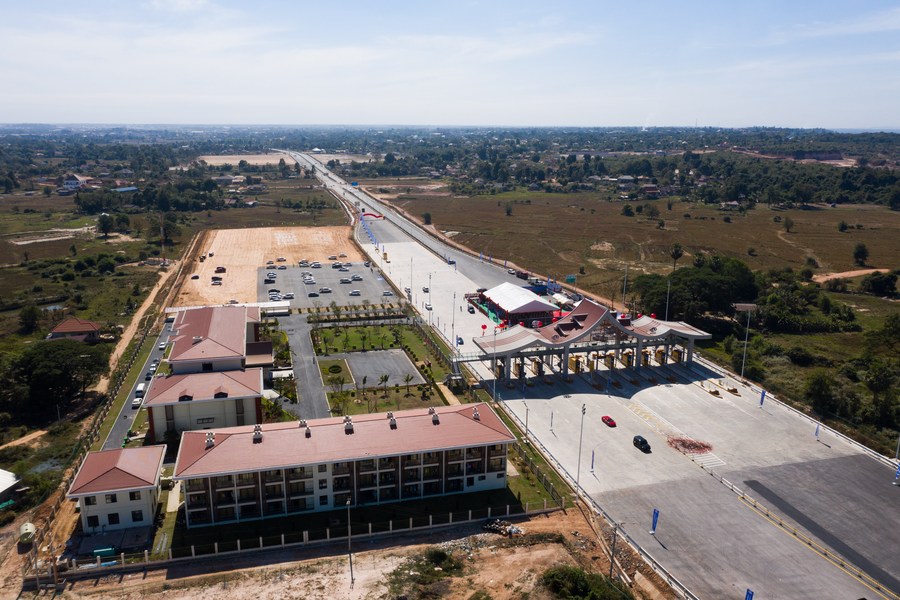
Aerial photo taken on Dec. 20, 2020 shows a view of the Vientiane-Vangvieng section of the China-Laos expressway in Vientiane, Laos. (Photo by Kaikeo Saiyasane/Xinhua)
The Vientiane-Vangvieng section of the China-Laos expressway, the first highway in Laos, was opened to traffic, cutting travel time from the capital Vientiane to the tourist town of Vangvieng from 3.5 hours to one hour.
VIENTIANE, Dec. 21 (Xinhua) -- The Vientiane-Vangvieng section of the China-Laos expressway, the first highway in Laos jointly constructed by the Lao government and China's Yunnan Construction and Investment Holding Group (YCIH), was inaugurated on Sunday.
The opening ceremony was held simultaneously in Vientiane, the capital of Laos, and Kunming of southwest China's Yunnan Province, via video conferencing.

Bounnhang Vorachith, general secretary of the Lao People's Revolutionary Party Central Committee and President of Laos, attends the opening ceremony of the Vientiane-Vangvieng section of the China-Laos expressway in Vientiane, Laos, Dec. 20, 2020. (Photo by Kaikeo Saiyasane/Xinhua)
Bounnhang Vorachith, general secretary of the Lao People's Revolutionary Party Central Committee and President of Laos, and Sonexay Siphandone, Deputy Prime Minister and Minister of Planning and Investment, in Vientiane, joined Ruan Chengfa, secretary of the Communist Party of China (CPC) Yunnan Provincial Committee and the province's Acting Governor Wang Yubo, in Kunming, together with representatives from China and Laos, to attend the ceremony.
The China-Laos expressway starts in Vientiane and ends at the Laos-China border town of Boten, with an approximate length of 440 km. The project adopts Chinese technical standards for construction and operation and is planned to be implemented in four phases. Construction of the first phase, namely the Vientiane-Vangvieng section, kicked off on Dec. 30, 2018 by YCIH in cooperation with the Lao government.

Photo taken on Dec. 20, 2020 shows a view of the Vientiane-Vangvieng section of the China-Laos expressway in Vientiane, Laos. (Photo by Kaikeo Saiyasane/Xinhua)
The Vientiane-Vangvieng section, opening to traffic on Sunday, is about 110 km long, designed as a two-way four-lane expressway with a design speed of 80 km to 100 km per hour.
The Vientiane-Vangvieng section, 95 percent invested by YCIH and 5 percent by the Lao government, is to be operated under the Build-Operate-Transfer (BOT) model for 50 years.

Aerial photo taken on Dec. 20, 2020 shows a view of the Vientiane-Vangvieng section of the China-Laos expressway in Vientiane, Laos. (Photo by Kaikeo Saiyasane/Xinhua)
There are 36 bridges, 402 culverts, seven interchanges, 11 separated interchanges, one tunnel, eight toll gates, three service areas, and two parking areas along the road.
Construction of the Vientiane-Vangvieng section has overcome multiple difficulties, especially those caused by the COVID-19 epidemics. The journey from the capital Vientiane to the tourist town of Vangvieng will be shortened from the 3.5 hours to one hour.

Photo taken on Dec. 20, 2020 shows the central control room of the Vientiane-Vangvieng section of the China-Laos expressway in Vientiane, Laos. (Photo by Kaikeo Saiyasane/Xinhua)
After its completion, the China-Laos expressway will become the backbone of central and northern Laos' transportation, promote the economic and social development in Laos, and will help accelerate the construction of a rapid transportation network covering the entire Indochina Peninsula, the YCIH said in a statement.
The Chinese company hopes that it will be beneficial to the development of cross-border self-driving travel, cross-border logistics, cross-border commerce and cultural exchanges, as well as promote the building of the China-Indochina Peninsula Economic Corridor, regional economic integration and regional community with a shared future, and the Belt and Road Initiative implementation. ■



